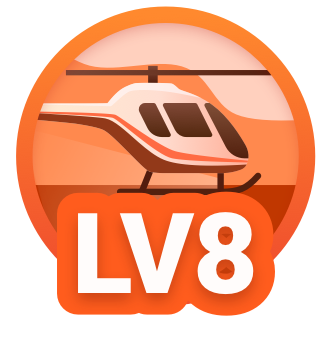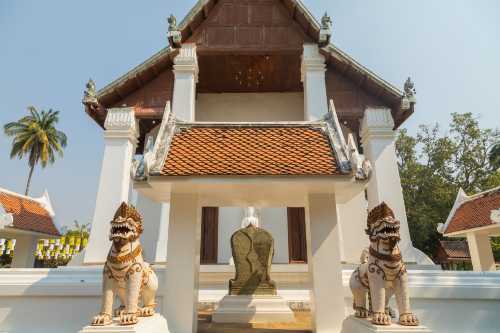App
Customer Support
Find Bookings
#GetDiscountsWithoutLuck #VisitSukhothai #ThaiTemple #BeautifulTemple #SililTrip "GivingAlmsToTheBlessingsAtTheSunSukhothaiBlessingSanBuri" Everyday at six in the morning, tourists can wait to give alms on the bridge. They can buy alms sets in front of the temple. Monks will walk to receive alms on the bridge in front of Wat Trapangthong. "Wat Trapangthong" is an ancient temple built during the reign of King Ramkhamhaeng the Great. Tourists can worship the sacred objects and admire the beauty of the interesting ancient architecture located on an island in the middle of a pond called "Trapangthong". There is a bell-shaped main stupa made of laterite as the base. In front, there is a white church standing tall in the middle of the water. There is a bridge across the pond on all three sides. Walk out of the chapel to the back and you will find a small white four-sided pavilion located on the same level as the chapel and the stupa. It is the place where the footprints of the Lord Buddha with 108 auspiciousness are enshrined. Walk to the south of the island. Here, there will be a statue of Phra Ruang, who was ordained as a monk, standing holding a broom and talking to the Khmers. Which protrudes from the ground, is the origin of the word "Khom Dam Din". The area around the temple is a beautiful and shady area and there is also fish food for sale for making merit in the temple area. It is considered that visiting once can make merit in a complete way, including giving alms, making merit, giving donations to fish, and worshiping Buddha. It is considered another place that should not be missed when visiting Sukhothai. Location: Tambon Muang Kao, Amphoe Mueang Sukhothai, Sukhothai 🕰️ Opening hours: Open every day
Slinslin
Ancient temple in the middle of a pond, Sukhothai province Wat Trapang Thong is located within the walls of Sukhothai city or to the east of the Ramkhamhaeng National Museum, Sukhothai. It is an ancient site located on an island in the middle of a pond called Trapang Thong. There is a main chedi in the shape of a bell, made of laterite as the base, while the upper part is made of bricks. Around the main chedi are 8 surrounding chedis. As for the chapel (the church), whose walls and roof are still quite intact, this is because about 100 years ago, Phraya Ronachai Chanyut (Garuda), the governor of Sukhothai, came to ordain as a novice and collected money to build the chapel. In 2005, the chapel was renovated again. An important thing about this temple is the footprint of the Buddha from the Sukhothai period, carved with 108 auspicious patterns. This footprint was moved from Khao Phra Bat Yai. Which Phra Maha Thammaracha Lithai built and enshrined at Khao Sumanakut in 1902 #VisitHistoricalSite #Mr.Tourist
นายท่องเที่ยว
#Get a discount without relying on luck# Wat Sri Sawai is located about 350 meters south of Wat Mahathat. This important ancient site is located in the glass wall. It consists of three prangs in the Lopburi art style. The prangs are quite slender and located on a low base. Some of the stucco patterns resemble those on Chinese porcelain. During the Yuan Dynasty, a lintel carved with the image of Narayana reclining on the ocean was found, parts of idols, and a lingam, showing that it was once a Hindu temple. It was then converted into a Buddhist temple by adding a chapel at the front, and later became a Buddhist temple. Wat Sri Sawai was originally a Brahman or Hindu temple. It is a three-tiered Khmer prang with a moat surrounding the three prangs. This ancient site originated from the Khmer castle style, but it has been modified from the original, for example, the decorative parts of the Khmer castle called banthaeng have become jackfruit petals, and the stucco decorated with jackfruit petals in the shape of Garuda fighting the naga and angels. The prang of Wat Sri Sawai is therefore different from the prangs of the Ayutthaya period, which are prototyped from. The prang in Khmer art is more similar to the Khmer style than the prang in the Sukhothai style.
เปรมยุ
#GetDiscountNotDependingOnLuck#WatMahathat is the largest temple in the city. It was built in the 18th Buddhist century or the early Sukhothai period. In the stone inscription of King Ramkhamhaeng of 1835 B.E. (Pillar 1, Side 2, Lines 23–26), it is mentioned that "In the middle of Sukhothai city, there is a viharn, there is a Buddha statue", which means the royal temple on the east side of the main chedi used to be the place where a Sukhothai-style bronze Buddha statue was enshrined, 6.25 meters wide at the lap. Phra Maha Thammaracha Lithai ordered it to be cast and celebrated in 1904 B.E. WatMahathat also has important components, namely the Mahathat Chedi and 8 surrounding prang-shaped chedis, which act as chedis for each side (direction). They are influenced by Khmer art and have stucco patterns influenced by Sri Lankan art. The chedis at the four corners are five-spire castle-shaped chedis influenced by Bagan-Hariphunchai-Lanna art. They are considered one of the most complete examples of authentic Sukhothai castle-style chedis left in the world. Wat Mahathat was announced as an ancient monument in the Royal Gazette Volume 52, Part 75, dated March 8, 1935. The ancient monument group, the area of the temple is 200 meters wide and long on each side. There is a Mahathat pagoda in the shape of a lotus bud or a rice bundle as the main landmark of the temple. Inside, there are various types of pagodas, bases of the temple, bases of the chapel, and niches for Buddha images, consisting of: Mahathat pagoda is the main pagoda in the middle of the temple. It is shaped like a lotus bud or a rice bundle. It is located on a three-tiered sky level. Around the base of the lowest level are stucco sculptures of disciples walking with hands together. The size of the pagoda base is 27 meters wide and 29 meters high on the same base. There are 4 prangs in front of the pagoda in all 4 directions. At the corners of the four directions, there are 4 pagodas in the Srivijaya and Sri Lankan castle styles, located as subsidiary pagodas of the main pagoda. There are 200 minor pagodas. The bases of the temple are of 10 different sizes, including the Phra Sri Sakyamuni shrine. Located in front or east of the Phra Mahathat Chedi, 8 niches, the base of the chapel, located on the north side of the Phra Mahathat Chedi, 14 meters wide, 25 meters long, made of bricks, 4 ponds located on the north and west sides, and a glass wall made of bricks surrounding the temple area on all 4 sides, 200 meters wide and long on each side.
เปรมยุ
#GetDiscountNotDependingOnLuck Wat Sri Chum is an ancient religious site located outside the northern city wall of Sukhothai Historical Park, Muang Kao Subdistrict, Mueang Sukhothai District, Sukhothai Province. This temple enshrines a large Buddha statue in the Mara-Vijaya posture called "Phra Atchana". The Buddha statue is enshrined in a pavilion, which has now collapsed, leaving only the surrounding walls, making it an outdoor Buddha statue to this day. The structure of Wat Sri Chum is more special than other temples in Sukhothai Historical Park because it does not have a main chedi, but is replaced by a pavilion enshrining a Buddha statue inside, which is located behind the main chapel. This temple is believed to have been built during the reign of King Ramkhamhaeng the Great, or around the 19th Buddhist century. It was first restored by the Fine Arts Department in 1953 and the pavilion area was restored again in 1967. Phra Phuttha Atchana is considered one of the most important tourist attractions and symbols of Sukhothai Historical Park. In addition, the area on the northern side of the pavilion also consists of a large wild mango tree that is more than 200 years old, with a height of more than 20 meters. It has been preserved and registered as a national heritage by the Ministry of Culture. "Wat Sri Chum" comes from the original local word meaning Bodhi tree. Therefore, the name Sri Chum means a grove of Bodhi trees. However, in the book of the Royal Chronicles of Ayutthaya written in the late Ayutthaya period, this meaning was not understood, so the place was called "Rishi Chum". Wat Sri Chum is assumed to have been built during the reign of King Ramkhamhaeng, as stated in the Sukhothai Inscription No. 1 that At the foot of the bed of Sukhothai city... there is Phra Achana, there is a castle. The principal Buddha image in the pavilion is therefore called "Phra Achana". The pavilion is 32 meters wide on each side, 15 meters high, and the walls are 3 meters thick. The left wall has a hole for a staircase. The wall leads to the roof. There are old paintings on the walls of the tunnel, but almost all of them are faded. This painting is almost 700 years old. The ceiling and walls have 50 slate slabs carved with lines depicting stories from various Jatakas, arranged continuously. All of these are considered to be the oldest Thai paintings. During the Ayutthaya period, when Somdet Phra Naresuan the Great declared independence in 2127 at the city of Kraeng, causing other cities to cancel their tributes to the Burmese, but there was still the city of Cheliang (Sawankhalok) that refused to comply with his royal command. So he led his army to conquer Cheliang and gathered his army at Wat Sri Chum before going to attack Cheliang. Since the battle was between Thais and other Thais, the soldiers were not motivated to fight. Somdet Phra Naresuan therefore planned to boost the soldiers’ morale by having one of his soldiers climb up the stairs behind the Buddha image and speak words of encouragement to them, which gave the soldiers the motivation to fight. As a result, the legend of the talking Buddha at Wat Sri Chum arose. Phra Naresuan also held the water-pouring ceremony to pledge allegiance at this temple. According to evidence, this temple was extensively renovated during the reign of King Lithai and has been continuously maintained. It is assumed that this temple was abandoned during the late Ayutthaya period until the reign of King Rama IX when a renovation project was launched in 1952. The restoration of the Phra Achana Buddha image was initiated by Professor Silpa Bhirasri and Professor Khian Yimsiri. As a result, the temple is in its current state. "Phra Achana" The word Achana has been interpreted as referring to the Pali word "Ajala", which means "one who is unshakable, steadfast", "one who is worthy of respect and worship". Phra Achana is a Buddha image in the Mara-Vijaya attitude, sitting cross-legged. The material is stucco, the inner core is made of brick and laterite. The lap is 11.30 meters wide and 15 meters high. The Buddha image is large and fills the entire temple. It is in the Sukhothai style.
เปรมยุ
#Get a discount without relying on luck#Travel to Sukhothai #Cheap accommodation #Silil Trip " Old City Boutique Hose " Today, I will recommend a cheap and good accommodation near the tourist attraction of Sukhothai Historical Park. Wake up early and walk to give alms in front of Wat Trapang Thong. It is convenient and you don't have to worry about food because there is a 7-Eleven at the entrance of the alley. In the morning, after giving alms, you can walk around Wat Trapang Thong and end with buying delicious food at the morning market. There are many types of rooms to choose from, both single beds, double beds, or family rooms. In the morning, coffee and fried dough sticks are served in front of the counter in front of the accommodation. There is a convenient parking lot. If you want to visit the historical park, you can walk out. Most importantly, the room price is not expensive. The owner of the accommodation is friendly and lovely. He gives good advice. If you have to pay this price, it is worth it. Location: 326 M.3 Muang Kao, Mueang Sukhothai 64210 Contact number: 0932253838
Slinslin
Popular Trip Moments
Sukhothai's Ghost General: War Dust, Crickeg Psalms And Art Of Surrender | Wat Si Sawai: Where Shiva's Prangs Bleed Beneath Buddha's Stucco Skin | Wat Mahathat: Sukhothai's Decapitated Divinity And The Dawn That Gilds The Grave | Luxury resort where architectural beauty harmonizes with deep nature | Recommended for a "Journey of the Heart" in Thailand! | A peaceful UNESCO 📍sukhothai | BAAN MA-KWID Sukhothai | Ban Na Ton Chan: The Charm of Rural Life Amidst the Mountains | 🧋The Nature | ☕ The Nature | 🌅 Give alms to monks on the bridge of merit, welcome the Sukhothai dawn at Wat Trapang Thong. | Visit "Sukhothai Historical Park" | Review of Wat Si Chum, Sukhothai - A must-visit destination in your lifetime! | Twilight Alchemy: Sunsets over the Sukhothai Historical Park | Agape Coffee Agape Sukhothai | Uncle Joy's Shop, Sukhothai | 💢 Thinking of taking a break? Think of Sabai Dee House Sukhothai. | The Nature Cafe | Sweet Rice Cafe @Sukhothai
Recommended Attractions at Popular Destinations
Popular Attractions in Bangkok | Popular Attractions in Manila | Popular Attractions in Tokyo | Popular Attractions in Taipei | Popular Attractions in Hong Kong | Popular Attractions in Seoul | Popular Attractions in Kuala Lumpur | Popular Attractions in Los Angeles | Popular Attractions in Shanghai | Popular Attractions in New York | Popular Attractions in Shenzhen | Popular Attractions in Osaka | Popular Attractions in Singapore | Popular Attractions in London | Popular Attractions in Guangzhou | Popular Attractions in San Francisco | Popular Attractions in Beijing | Popular Attractions in Macau | Popular Attractions in Bali | Popular Attractions in Jakarta | Popular Attractions in Paris | Popular Attractions in Ho Chi Minh City | Popular Attractions in Istanbul | Popular Attractions in Phuket | Popular Attractions in Chicago | Popular Attractions in Seattle | Popular Attractions in Toronto | Popular Attractions in Orlando | Popular Attractions in Cebu | Popular Attractions in Chiang Mai
Popular Restaurants in Sukhothai
Baan Junshine | Poo Restaurant | Bike Mania Beer Room | Dream Cafe | Artitaya Restaurant | Nham Khang Sukhothai Restaurant | An-Guy Coffee | Thara Restaurant | The Alibaba Indian Food | Maeboonmee | MAI PRA DIT Coffee and Bistro | Old City Landmark Cafe | Sukhotai Seafood | Sabaidee Guesthouse | Mai Krang Krung | Felice' | Mangkon Khap Kaew | Mrs.Ann Bakery & Coffee | 379 Drip | Black Sugar | Coffee House | Bami Meng | Kacha | Say Hi Cafe | Foresto Restaurant | Kacha Cafe & Restaurant | Pa Ouan Moo Jum | Kaeng Sak | The Coffee Cup | Ploy Chompu Kitchen
Popular Ranked Lists
Popular Luxury Hotels in Costa Adeje | Popular Premium Hotels in Nakhon Pathom Province | Popular Trending Attractions in Osaka | Popular Premium Hotels in Ica | Popular Trending Attractions in Sanya | Popular Trending Attractions in Dalian | Popular Trending Attractions in Changzhou | Top 50 Must-Visit Restaurants in Munich | Top 10 Local Restaurants in Lushan Global Geopark | Top 20 Trending Attractions in Shanghai | Top 50 Must-Visit Restaurants in Macau | Top 50 Luxury Hotels near Kempten | Top 10 Trending Attractions in Jeju | Popular Premium Hotels in Thanh Hoa Province | Popular Premium Hotels in East Kazakhstan | Top 10 Trending Attractions in Qinhuangdao | Popular Trending Attractions in Paris | Popular Luxury Hotels in Norwood | Popular Trending Attractions in Singapore | Top 50 Must-Visit Restaurants in Songyang | Popular Premium Hotels in Canterbury | Top 50 Must-Visit Restaurants in Santorini | Popular Trending Attractions in Dunhuang | Top 10 Trending Attractions in Xi'an | Popular Premium Hotels in Bangka Belitung Islands | Top 50 Must-Visit Restaurants in Bruges | Top 50 Must-Visit Restaurants in Hanoi | Top 50 Must-Visit Restaurants in Dalat | Top 10 Trending Attractions in Kyoto | Top 10 Trending Attractions in Chun'an
About
Payment Methods
Our Partners
Copyright © 2025 Trip.com Travel Singapore Pte. Ltd. All rights reserved
Site Operator: Trip.com Travel Singapore Pte. Ltd.
Site Operator: Trip.com Travel Singapore Pte. Ltd.





















